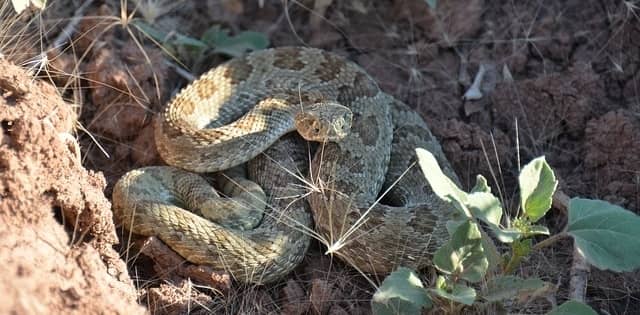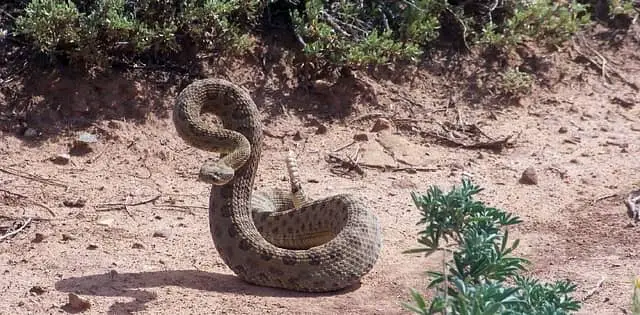A snake bite is not a box anyone wants to check on their bucket list. For those who don’t know much about snakes, you may not know that a simple rubber boot will not protect you against snake bites.
The University of Florida’s Department of Wildlife Ecology and Conservation listed events that tragically wound people yearly. You’re more likely to have one of the following happen to you instead of a snake bite: spider bite, dog bite or attack, lightning strike, car or motorcycle accident, or lung cancer. In fact, only one in 37,000 people will be bitten by a venomous snake and of these, only one in 50 million people would die from it.
Even though those odds are pretty good, who wants to risk a snake bite? If rubber boots are not enough to protect us from snake bites, what do we need? Read on to find out more about how to keep safe from these often-hidden creatures.
How do you protect yourself from snakes while hiking?
Snakes are not looking to befriend humans. Let me repeat this in another way – snakes want nothing to do with you. That said, they will attack if bothered or threatened. Snakes can attack at a distance of about half their body length so it is imperative you do not try to go toward them to move them or provoke them to scurry along.
Stomp around
Protect yourself from causing these slithering earth-mates from lashing out and sinking their fangs into your calf. If you see a snake, stomp the ground from a distance. The snakes feel the vibrations and hopefully move on without feeling threatened. Make sure you are a distance away from the snake so if they feel threatened, they do not strike out.

Watch your hands and feet
Before you put your hands or feet anywhere where you can’t fully see the ground, take a look to ensure there isn’t a snake hidden. For example, let’s say you’re about to step over a downed log. First, look at the log to ensure you are not about to step into a hole in the log and then step on it as opposed to over it. If you cannot see to the other side of the log, what is to say a snake isn’t laying on the other side?
The same with your hands. It would do you well to not lean on or reach in any area you cannot clearly see. Tall grass, hollowed logs, or anywhere else with an obstructed view is an ideal hiding spot for a snake.
Tools
Basically, have a pole or hiking stick with you. Use this to clear away brush, extend your reach, and to check out areas you cannot clearly see. It’s much better that fangs are sunk into the wood of your stick than your wrist.
Clothing and shoes
Most snakes are going to lash straight out and bite in front of them, meaning your ankles, shins, calves, and hands are most at risk. Tight fitting clothing equates to a snake bite being closer to your skin. To prevent that, wear looser pants, gaiters, or waders to keep a bit of dead air between a potential bite and your legs. It wouldn’t hurt to invest into a pair of snake gaiters if you frequent areas with potential deadly snakes.
We recommend Crackshot Snake Guardz Click the link for more info.
Available for purchase are also gloves and boots specifically for preventing snake bites. These products are specifically made with tougher material, so a snake’s sharp fangs have little chance of penetrating the material. More on snake proof boots below.

Do snakes avoid humans?
Consider for a moment how much larger humans are than snakes. Now imagine if something that much bigger than you suddenly started moving your way. Would you want anything at all to do with it?
Chances are, you answered no. Snakes are the same. They do not like you, want to be picked up by you, or care about your intentions. It isn’t that they fear you – they just don’t want anything to do with you.
Typically shy and quite a bit smaller than us, we are seen as a threat. They are not looking to run into the fire, so to speak, so they stay away and want to be left alone. Most often, you leave the snake alone and it will leave you alone.
When hiking, we are essentially walking into their house. Imagine the unwanted and unruly house guest: loud, obnoxious, and belligerent. They start running into things, knocking over furniture, spilling drinks on the couches. Eventually, after getting riled up, they begin getting dangerously close to you – poking, prodding. You feel threatened. You look up to see their hand swinging toward you and you defend yourself.
This is a snake’s life when you go hunting. They aren’t looking for a fight but if they feel threatened or surprised, they will attack. Perhaps your house guest was just looking for another drink and swung his arms but, in the moment, you didn’t perceive it that way. A snake won’t analyze your intentions but will just react.
So, while snakes will avoid humans, should you stumble into the path of one while taking a walkabout, observe it from afar. If the snake already seems a bit put out, clearly back up and keep your distance.

How high can a snake strike?
A snake that is irritated or aggressive is a bit unpredictable and can come toward you to attack, decreasing the distance between you and thus a normal striking range becomes a bit of an obsolete point. Typically, if a snake is coiled, it can strike between 1/3 and ½ of its length. With less accuracy, some snakes can strike from 2/3’s of its body length.
Are snakes able to bite through waders?
Waders are not designed specifically for snakes. Waders are designed to give the wearer the ability to walk through water without becoming drenched, heavy or cold. There are rubber, neoprene and synthetic waders and their function is to keep the wearer warm and dry.
With some searching, you can find snake-proof chaps but many descriptions say they cannot guarantee against a snake bite. Waders can be purchased and paired with snake boots.
What waders will provide is distance between your leg and the material. If a snake were to attack, there is a bit of dead air which can at least prevent some of the venom from entering your body.
What are snake proof boots?
As mentioned earlier, there are some clothing protections you can use to prevent snake bites. Snake proof boots are one such example. These boots are designed to protect you in the unfortunate event a snake does try to strike. Most bites are to the ankles and lower legs, so the boots tend to travel up the leg to protect this area.
Many people who are regularly going hiking in brush, hunting, or even wading use these boots to provide peace of mind. If you are simply mowing your grass, it is probably not necessary to purchase the boots but if your activities are putting you in a position where a snake encounter is a matter of time, it is worth the cost of the investment.
When are snake boots necessary?
Here is the deal with snake bites – at a minimum, you are in a bit of pain, have some notable bleeding and maybe can’t walk on it for a few weeks. At worst, you are dead within hours after its venom has first made you delusional and has robbed you of normal bodily function and thought.
When you are considering if they are necessary, you must decide if where you plan on being in a place where fate can tempt you. Snakes aren’t slithering about trying to find ways to bite you but they are going to protect themselves and hide away from obvious sight.
Wear snake boots if you frequent an area where snakes are and you plan on really getting into their territory. If there is a chance you could accidentally step on one, wear the boots. Because they blend in their natural environments, it’s probably going to be after the bite when you even realize it is there. Further, if you plan on going out alone or are in the wilderness, quite away from a hospital or cell phone tower, wear snake boots.
How do you wear snake boots?
Snake boots are designed to go on the outside of your pants. By tucking your pants leg into your snake boots, you prevent anything going up your leg. In areas where there are snakes, you will likely have ticks, bees, insects, chiggers, and more. They will stay on the outside of your body by blocking their entrance-way.
Some boots are able to be laced up, which is of importance if you have larger calves. If this is the case and you are going where there may be brush containing thorns, you can swap out your laces for firemen’s work boot laces. Many snake boot users have said this does the trick for preventing brush sticking to the laces.
How effective are snake proof boots?
A snake’s bite force is higher than a Rottweiler and therefore the boots must be made to stand that level of power. By testing the boots, reputable companies have developed boots that can withstand this. Most snake bites will not penetrate the snake proof boots. That said, boot only go up so far so you must use common sense and not develop a false sense of security when wearing them.
What are snake proof boots made of?
Much like waders, snake boots vary depending on what environment they are to be used. You can find boots designed for hot and arid climates as well as wetlands. Across the board, however, you can expect the boots to be pretty heavy and are not necessarily great for long treks or hiking due to the weight.
Most snake boots use a combination of leather, rubber, plastic, neoprene, polyurethane, nylon and other synthetic materials. The way the materials are layered or integrated is in such a way that the boot is unable to be penetrated by the snake’s fangs. This protection travels up the boot, which normally falls below the knee.
Some boots provide a snake-guard lining. This lining goes between the inner and outer material of the boot and provides flexibility. After all, you wouldn’t want to go fishing, hiking or hunting in a cast so why would you want your boots to feel as such.
Despite the way the material is combined, manufacturers of the snake boot will test the boot to ensure it cannot be penetrated. LaCrosse Footwear sends their boots for a third party test using a balloon. If the snake pops the balloon inside the boot, the boot fails. Muck Boot Co utilizes a similar approach by filling the boot with a latex bladder. The snake handlers then work to make the snake attack the boot. If the bladder is penetrated, the boot does not pass its benchmark.
When you are searching for a particular boot, check out the materials and the environments they are designed to be used in. This will help to ensure you are not purchasing a boot that while provides excellent protection does nothing for maintaining a semblance of normal body temperature.
How do you break in snake boots?
Like most boots, snake proof boots also have a break in period. The more times you wear them out, the quicker they will break in. If at all possible, try them on before purchasing. Heel height, insulating liners, insoles, and arch support all make differences. It would be disheartening to spend the money for a nice pair of boots to realize there is no way you can spend more than 30 minutes in them.
How do you waterproof snake boots?
Many snake boots are already waterproof or at least water resistant. However, depending on the material used to create the boot, they may not be. Leather is a common material to be used in boots because it is difficult for the snake to bit through the leather and yet, it is commonly known that leather and water do not mix.
A rubber-based snake boot would be your best bet for being totally waterproof. However, if you are not sold on this, there are some tricks regular wearers have shared. Obenauf’s heavy-duty leather preservative, silicone waterproofing spray, Scotch guard and seam-sealing products have all be applied by snake boot wearers to prevent leaking water. Most of these tricks last at least a year before reapplication is needed. Take note that although they may help with the waterproofing, they may also decrease the breath ability factor of your boots yielding to more foot sweat.
How high should snake boots be?
Snake boots are necessary for anyone planning to spend time where snakes frequent, especially if those snakes are venomous. With this in mind, it is worthwhile to take note of how large the snakes are and how high they can attack. If a snake is in the area you live and it can attack above the thigh but you are only concerned with knee high, you are not protected. Most snake boots fall below your knee, since the majority of snakes will attack between the ankle and the lower leg.
Are snake boots worth it?
This is a question only you can answer. If you are going out often in areas where snakes live, by all means, the price of the boots is minor compared to your life. If you are mostly traveling in the city, walking through well-manicured lawns and are not really into hiking or nature, then probably not. Whichever way you decide, at least read up on snakes in the area so you don’t stress that a common garden snake is a copperhead.
Having said that, for example let’s look at the Florida Everglades. It’s being taken over by the Burmese Python and Anacondas. These snakes are an invasive species to this area. It’s thought that the cause of them being there is from owners of exotic pets no longer wanting them as pets, so they let them go and they find their way into the swamp. These snakes have learned to adapt quickly to this environment because it’s close to there native homeland. The destruction that they are causing to the natural wild life in the everglades is having a major impact. These snakes don’t have any real natural predators in Florida, so this gives the snakes the upper hand or free reign over any animals in their path. One thing is for certain this is an area of land where I’d want to be wearing snake proof boots for sure.

Florida python hunting
If you hunt and feel like helping out with eliminating the Florida pythons make sure to check out the South Florida Water Management District’s website to sign up and become a python removal agent. You need to fill out an application form and there’s also a lot of great info on the site to get you in that direction. Click here for more information.

